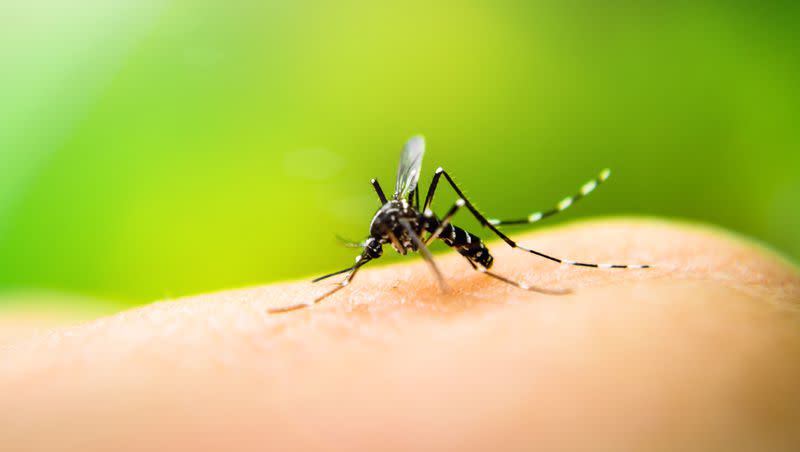Malaria has spread in a 3rd state. Here’s what Utahns should know

Locally acquired malaria, which hadn’t been seen in the United States for two decades until earlier this summer, has now been reported in a third state.
Maryland officials announced late last week that a case had been confirmed in a resident living in the Washington, D.C., area who had not traveled recently outside the country or to the other states where malaria has been transmitted, Florida and Texas.
The patient, whose age and gender were not made public, was hospitalized and is now recovering from the deadly mosquito-borne disease caused by a parasite, according to a news release from the Maryland Department of Health.
Dr. David Blythe, director of the department’s Infectious Disease Epidemiology and Outbreak Response Bureau, said the patient had gone to the hospital because of a fever and sweating, NBC Washington reported.
Related
Blythe said the patient may have gotten malaria after being bitten by a mosquito that had picked up the parasite by biting a recent traveler who’d returned with the disease. He said the strain is different from the locally acquired Florida and Texas cases.
“One of the ways that this could happen is that a person who has traveled to somewhere where malaria is more common gets the infection and comes back to Maryland, a mosquito bites that person and then bites someone else who hasn’t traveled,” he said.
Maryland Department of Health Secretary Laura Herrera Scott said in a statement that officials “are taking this very seriously” and are working with local and federal health officials to investigate the case.
“Malaria was once common in the United States, including in Maryland, but we have not seen a case in Maryland that was not related to travel in over 40 years,” the health secretary said.
About 2,000 cases of malaria are diagnosed annually in the United States, according to the Centers for Disease Control and Prevention, usually in travelers or immigrants coming from places where transmission occurs, particularly parts of Africa and Asia.
Starting in May, malaria has spread in the United States for the first time since 2003. The CDC said in late July there is no reason to believe the seven locally-acquired cases in Florida and one in Texas are related.
Is there malaria in Utah?
There are still no confirmed locally acquired malaria cases in Utah, Kacy Nowak, a zoonotic and vector-borne disease epidemiologist with the Utah Department of Health and Human Services, told the Deseret News.
But Nowak said as of Monday there have been eight reported cases of malaria in Utah this year. That’s two additional cases since mid-July, when state public health officials said there had been six cases of malaria in Utah, all contracted during overseas travel.
Five of the earlier Utah patients had traveled to Africa and one to Central and South America. She said one of the new cases also had a travel history in multiple Central and South American countries, while the other is still under investigation.
“Utah’s risk of locally-acquired malaria remains very low, and our response remains the same,” Nowak said, citing the state’s low numbers of both the Anopheles mosquito that spreads malaria and cases of the disease.
She said for malaria transmission to happen in Utah, the specific species of mosquito would first have to bite someone infected with the disease and then survive the roughly two weeks it takes for the malaria parasite to develop before biting someone else.
Such a “‘perfect storm’ sequence is a very low risk in Utah,” Nowak said, noting state and local experts including mosquito abatement districts ”continue to be in regular communication to survey for any possible risk of disease transmission that may occur.”
How Utahns can protect themselves against mosquitoes
Nowak offered a list of “simple precautions” Utahns can take to avoid all mosquito bites:
Anopheles mosquitoes bite in the evening (6-10 p.m.) and the early morning (3-5 a.m). Outside during these times? Then wear long sleeves, long pants and covered shoes, and use an insect repellent with 20% to 30% DEET, which is safe to use during pregnancy. Repellents are not recommended for children younger than 2 months of age.
Consider rescheduling outdoor activities that occur in the evening or early morning.
Anopheles mosquitoes prefer to lay their eggs in clean, unpolluted water such as fresh- or salt-water marshes, grassy ditches, the edges of streams and rivers and small, temporary rain pools. Remove any puddles of water or standing water including in pet dishes, flower pots, wading and swimming pools, buckets, tarps and tires.
Report bodies of stagnant water or densely populated mosquito areas to your local mosquito abatement district. Go to http://www.umaa.org/ for a list.
Keep doors, windows and screens in good condition and make sure they fit tightly.
Before traveling to areas that may have malaria and other mosquito-borne illnesses such as Zika or dengue, consult with an immunization travel clinic and take the necessary precautions.

